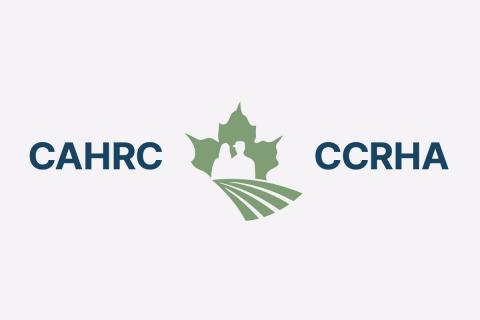Supporting all sectors of agriculture
The Growing Opportunities Student Wage Subsidy program (SWPP) offered by the Canadian Agricultural Human Resource Council (CAHRC) is helping change the agriculture labour market – one business at a time. One such company that has taken advantage of this initiative is Greig Seafood Newfoundland based out of Marystown, Newfoundland. Grieg farms Atlantic salmon.
Kevin Smith, R&D and Sustainability Officer with Greig, says that a lot of people don’t consider fish farming as farming. But it is. Fish are kept in giant fish tanks on land that mimic their natural environment, then they are transferred to marine net pens in the ocean. The stock is sterile, so that in the event of an escape they can’t breed with the native species.
“The problem is that a lot of funding agencies classify our operation as fisheries and not farming,” he comments. “They don’t consider it agriculture.”
It’s not always easy for Grieg to find the workers they need. And it’s extremely difficult to operate a crew with vacancies.
“There’s lots of people here with a fishing background, but they’re missing the fish farming piece,” Smith says. “The challenge for us is finding workers with the combination of maritime experience – the ability to work comfortably and safely at sea – and the necessary knowledge related to aquaculture, animal husbandry and biology.”
Now they have support to recruit people with the skills they need through CAHRC’s wage subsidy program.
Creating a valuable on-going relationship
Grieg Seafood started working with CAHRC in 2022 and they’re not looking back. It’s been an extremely beneficial venture.
“The great thing about CAHRC is that all our positions are considered ag,” comments Smith. “In other programs, we were eligible for support of specific roles, but not all roles. CAHRC’s wage subsidy program applies across the spectrum of roles and responsibilities.”
He adds, “Our gap was the result of not being able to find people with the skillset the job demands. Now we can do that. CAHRC lets you apply for the subsidy for a large volume of people – and that’s what we need. It makes it a lot less risky to bring on a group of untested employees when 50% of their wage is paid through the subsidy.”
Smith found out about the SWPP program through the Marine Institute at Memorial University who have been working with CARHC to help employers find workers. The Marine Institute offers both a technical certificate and an advanced diploma in aquaculture.
In 2022 through the wage subsidy program, Grieg hired two students who stayed on after their three-month work term. In 2023, there will be about 20 people graduating with a diploma that CAHRC will be helping Grieg hire.
“These students have the knowledge, background and logic behind the choices in our industry,” asserts Smith. They have the skillset to recognize when something isn’t right, when a feed response is poor or the weather isn’t suitable for fish feeding, which also helps make our jobs easier.”
“A real advantage is that we will end up with a great crew who understand our operation, which pays off for us big time when we hire these students back on a permanent basis,” he explains.
Providing valuable hands-on learning opportunities
It’s also of benefit to the students they take on.
“Marine technicians can fulfill many roles and responsibilities related to fish feeding, maintaining site equipment, transporting fish and harvesting,” says Smith. “The work experience provides them with an opportunity to take on a diversity of tasks and find out what their interests and passions are. They can even see it they’re cut out to be a supervisor or manager.”
He adds, “Many of the positions involve a week on, week off at sea, which just isn’t right for everyone. Working with us allows them to get a full picture of what a career with Grieg would look like, so they can vet us and we can vet them.”
Another very positive aspect is that this provides opportunities for students who want to remain in Newfoundland to do so.
“Being able to stay in the province is huge for many Newfoundlanders,” explains Smith. “They don’t have to go west to find work. Rather, they’re able to have a career and make a living right here at home.”
Supporting the future of agriculture
Smith says that if they didn’t have the financial support to bring on students, there’s very little chance that they would have taken the risk to do so.
“New employees require a lot of supervision and on-the-job training,” comments Smith. “The support for training and the subsidized work term makes it a lot less intimidating.”
He adds, “We’re big fans of CAHRC. I don’t have to worry about applying for a subsidy being an administrative burden. It’s quick and easy – they just require a few documents and follow ups. The subsidy amount is consistent with other programs, and they were able to approve the positions in advance of whether or not the students graduate, which is also very helpful.”
When asked if other agriculture employers should apply, he commented:
“If an industry is a fit for the subsidy program, you couldn’t ask for anything simpler. I can’t speak highly enough about it. In rural areas with an aging population and workforce, it’s an opportunity to bring students into our industry who might not otherwise have us on their radar. It’s also a great way to let young people know that this is an industry that has room for them, that it’s highly technical, challenging and sophisticated. In my opinion, it’s a no-brainer.”
For more information on the Growing Opportunities Wage Subside program, see the CAHRC website or contact Megan Lockhart, AgriTalent Project Coordinator at mlockart@cahrc-ccrha.ca.
